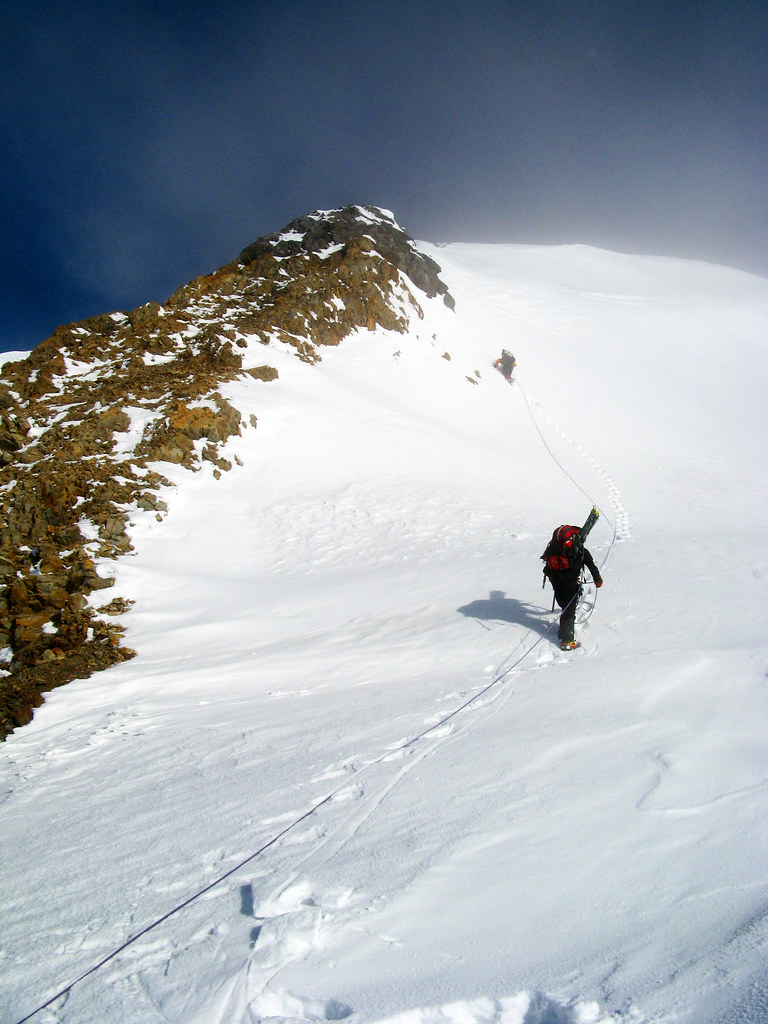 |
| The wall that looms over Camp 2: better than coffee |
As I watched the length of rope between Nate and Craig—and then between Craig and me uncoil slowly, I listened as it hissed softly, rhythmically with every step they took, pulling through a foot of dry Alaskan powder and wondered what today would hold for us.
That sound, I find, is both soothing and ominous in the deafening silence of such a wilderness, and its portent is never known until you yourself start moving, too.
Mentally and physically, I was fired and fueled for what I knew would be a lot of hard work today, but to be honest, I still had a quiet, nagging concern after what I considered a weak performance on my part yesterday.
Craig and I stood near each other, clipped in, just waiting for the person in front of us to stretch out the rope. But for better or worse, watching he and Nate make their way out of camp and slowly upward ahead of me gave me plenty of time to ponder my ability to get through the coming days that certainly held more monster climb days.
And then it was my turn to start moving out and up as Craig stretched it out. Immediately above our camp loomed the first challenge: a 100-foot wall of rock and snow that progressed sharply from horizontal at camp to near 70 degrees at the top. Five minutes later, halfway up that wall, I wryly noted that all thoughts but those of focus on the task at hand had vanished from my head.
Those initial moments marching out of camp in the morning are always interesting for me. With your pack on again—seemingly just hours after dropping it in exhaustion the night before and starting out cold once more—they're the moments that seem to set the tone for the whole day; the moments you know you'll either push through the brain and body fog from the previous night's sleep and go like a machine, or note with perhaps a hint of worry that the fog isn't clearing as you search in vain for a rhythm that isn't coming.
 |
| A view of the scorpion-tail of Mt. Hunter |
Our rope team order has now been well established. Nate leads, Craig belays from the middle, and I carry large bunches of 4-foot willow wands and mark our route. My other two jobs are 1) to pull the protection pieces Nate has placed above as I pass them—ice screws, snow pickets, and other anchors—and 2) to place those same protections for my team behind me as I lead the rope team on the way down.
A few days ago, I was in this same role in the larger group's carry from Crosson base camp up the fixed lines to Camp 1, but I was asked to leave those anchors in place as I passed them because we'd need them there the next day to move camp up the route, too.
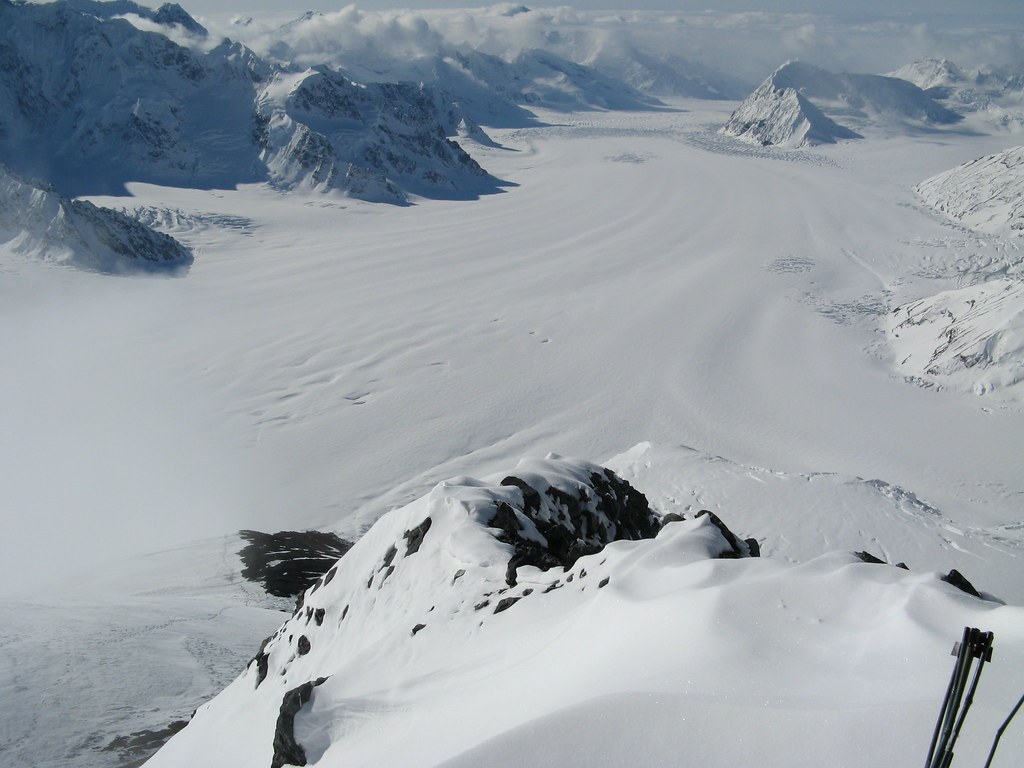 |
| A bunch of wands sticking out of my pack on a break stop. Oh yeah, and an INCREDIBLE view. |
But because today, like the other day, was just a carry and descent back to Camp 2, I followed what I thought was the correct protocol once more, and left all the pickets I passed right where they were in the snow, thinking logically based on yesterday, that we'd again need them tomorrow.
About 800 vertical feet up the route after some hard climbing, Nate stopped on a ledge and reeled us in on the rope, and then asked me for the pickets back. We hadn't explicitly discussed what I should be doing with them, but he assumed I'd been pulling them as I passed.
Stunned, I had to confess I'd left them all where they were on the way up. He was stunned, too. The problem was that the next sections of the climb above us were far steeper, of much higher-consequence and covered terrain that was significantly more exposed than we'd been on so far, and he needed every anchor we had to protect it.
A bunch of F-bombs ensued from both of us, and I felt soooo stupid… but after the shock of the predicament I'd put us in wore off, we started talking more seriously about real options. One suggestion was that we could just make it a mellow day today and cache the food and fuel we were carrying near where we stood instead of up high, and limit ourselves to just an 800 foot gain today—and then climb high tomorrow with maybe an extra back carry to retrieve the stuff.
One thing was certain, however: continuing upward with only the one picket and one ice screw was not an option, Nate said. We would need every piece we had to get up the next several sections, because it presented such serious exposure with just one slip.
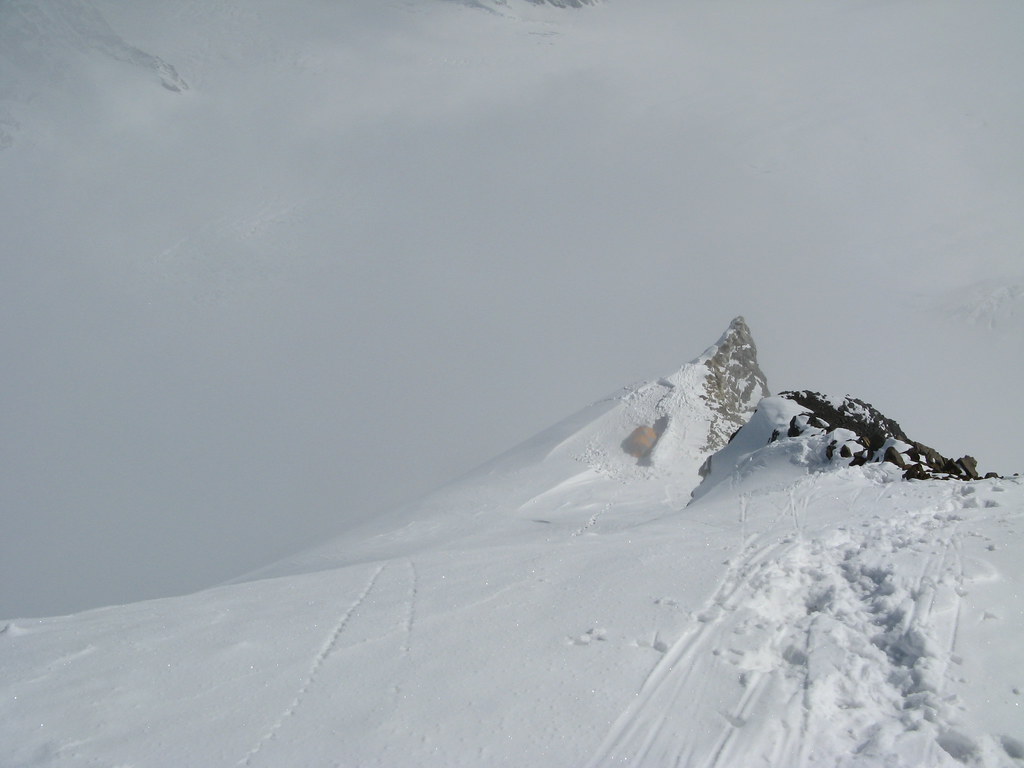 |
| Camp 2 from high on the ridge above. Check out the tent and wind wall. |
After we got our composure back and had a bunch of back and forth to try and solve the problem, and, I suggested we drop packs where we stood, I stay on rope and descend the last big ridge we now stood on top of, and go retrieve at least the two pickets placed on the slope below us—and then we could continue on up.
Throughout this exchange, I was mentally kicking myself so hard, and I apologized profusely for the error. I should have asked explicitly if I needed to pull them all, but Nate said he's shared the blame for not being specific, especially having left them behind intentionally the other day.
Nate then give us careful instructions for the next sections on up to the top of the mountain. "Be very, very surefooted with every step." And we were.
When we started climbing again, we were armed with five anchor pieces instead of just three pickets and one screw. Nate cleverly used his second ice axe as another anchor too. Neat!
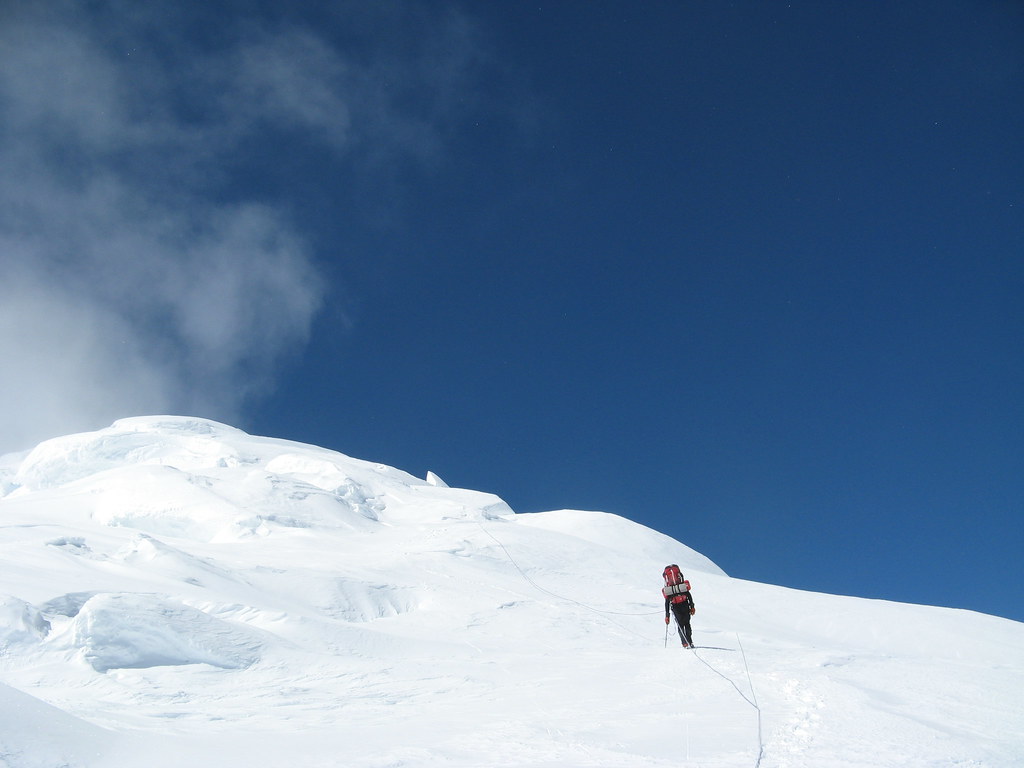 |
| Climbing... and climbing on Crosson |
We decided to cache the gear there and pick some more food and fuel up tomorrow as we passed through, so Nate scouted a spot for the cache hole and started chipping away laboriously with his ice axe adze at the near-rock-hard wind scoured snow, alternately chipping, and then shoveling it out.
We were standing on a huge, open flat area beneath what looked like giant snow blooms and graceful blue ice overhangs carved by the unceasing (and now howling) wind. Our stopping point was beautiful, but the wind had continually cranked up the higher we went, and it was bitterly cold.
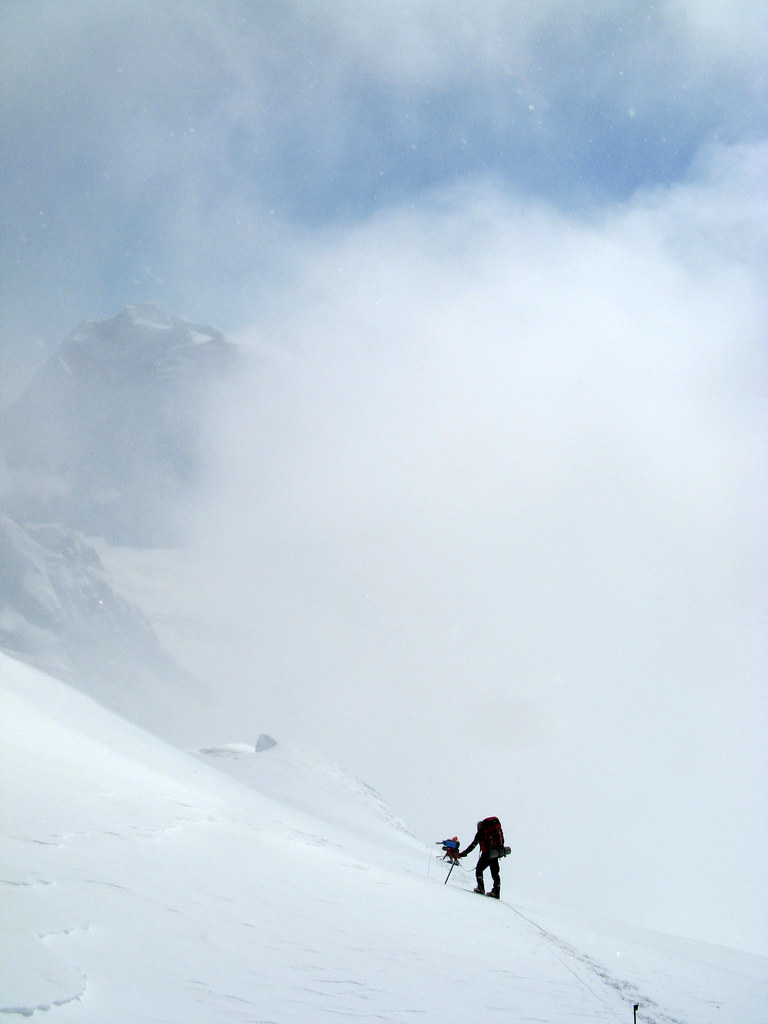 |
| The downclimb - rock-hard snow and a 3,000 foot drop to the glacier on our right. Don't slip. |
Pulling in to a spot like that after climbing hard and being all sweaty, one hesitates to put one's pack down, because it's keeping half your body warm. But I didn't want to see Nate chop that hole out all by himself, and it also gave me a way to stay warm the same time.
So we alternated chopping and shoveling for a bit, but the snow was so hard, it nearly took us nearly an hour and get a hole that was probably still too small for all the stuff we wanted to put in it. After more work, we'd finally gotten close to the size we needed it to be in the hard, hard snow, but in the last few strokes before we were to start filling it with group food, wands, and extra fuel, the adze of Nate's ice ax head snapped and whickered off into in the snow. It was destined to be a swearing kind of day, it seemed.
Several groups food bags, gallon cans of fuel, large bunches of wands that we will need up higher on the route, sacks of personal lunch food to last each person 8 days, plus all our huge puffy pants and jackets all went in the hole.
On the way up, my toes had gone cold—really cold—long ago, and I was concerned. When that happens, you can only do what you can do to keep the circulation flowing, because taking off your boots is not an option.
So there I stood, temperature dropping, wind howling, trying to fend off the deep, penetrating shivers that seemed to stab through every fiber of my puffy jacket with my toes damn near frozen. I began to stomp my feet, shake my arms and legs, and in doing so, I quickly came to understand just how quickly someone can get frostbite in a place like this (and we were only at around 12,300 feet).
 |
| Digging a hole at the cache site |
The subarctic is no place for the unprepared. I pulled my face farther and farther back into my multiple hoods and tried to hide behind my face protection to beat back the viciously cold winds, but my softshell pants and jacket, R1 hoody, wool base layer, and hooded puffy jacket were only just barely up to the task.
And in spite of my efforts, I could feel my toes going colder by the minute; but there was no sign of us getting moving for a bit. We still had to fill and mark the hole so we could find it tomorrow, and reset the rope for the long downclimb back to Camp 2.
It was in that moment that I began to worry about the condition of my toes in earnest, especially my left big toe, though all of them were pretty numb, so while we finished up, I alternately swung my legs and arms furiously to try and force blood down into my feet and hands. I had limited success, but some success is better than none.
I changed my tactics to scrunching my toes over and over in my boots to try and create a little friction in there—but again, with limited success. I began wishing for the huge puffy gear we had just buried in the hole, because the wind had picked up even further—but at last it was finally time to go.
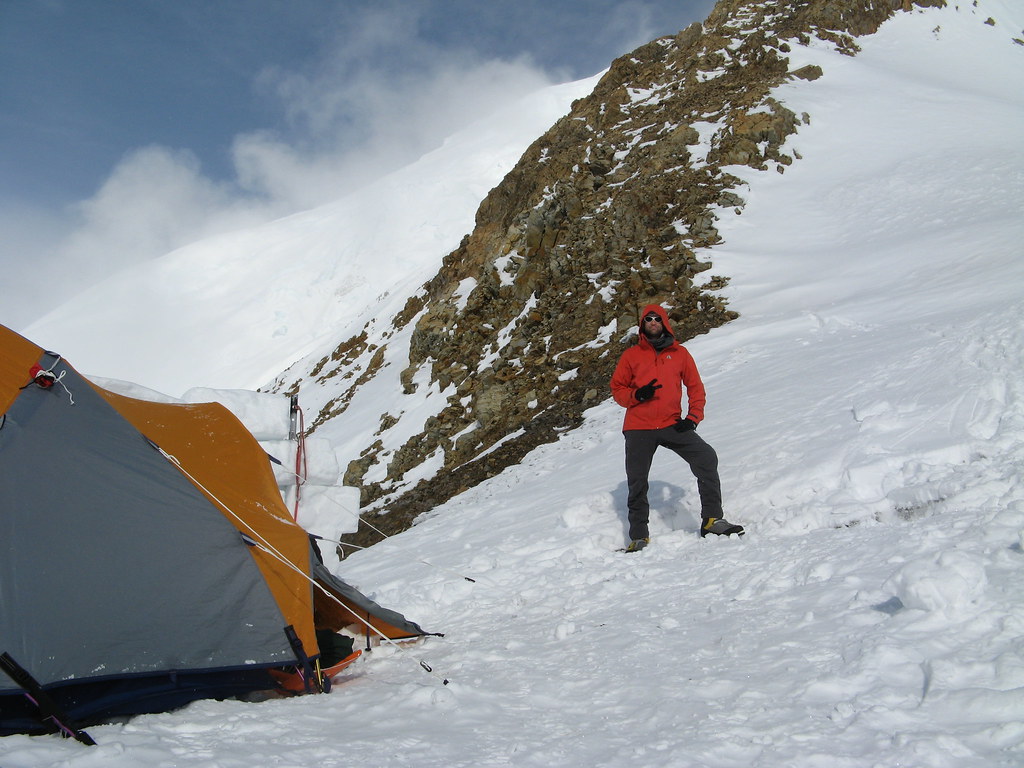 Nate had gotten everything buried, and he told me I'd be leading and placing protection on the way down, handed me what gear he had, reminded us once again about the importance of being surefooted on the descent, and off we went.
Nate had gotten everything buried, and he told me I'd be leading and placing protection on the way down, handed me what gear he had, reminded us once again about the importance of being surefooted on the descent, and off we went. I took it slow at first, but soon became more confident and rhythmic, banging in pickets where protection from falls was needed on the steepest and most exposed sections. It took us a couple of hours to get back to camp.
Almost immediately below our top-out point, we walked back into the protection of the ridge and the winds started to subside, and I was glad to be into lesser cold as we downclimbed the route we'd just ascended.
We'd drop sharply—60° - 70° off ridge after ridge, outcrop after outcrop, until finally camp appeared below us. I was exhausted. While Nate fired up the stove and began cooking a huge, filling, and awesome meal of Thai chicken and rice in spicy yellow Curry, complete with rehydrated powdered coconut milk (yum!), I sat in the tent vestibule and pulled off my boots, scared of what I would see when I got them off.
My toes were all pretty much in complete whiteout, but the big toes were definitely the worst. Nate asked me to test the capillary refill of them by squeezing them, and those results were not encouraging, but I started massaging my feet vigorously and continuously to get the blood flowing again.
After about 15 minutes of this, I became concerned that I was frostnipped… after 25 minutes, I was sure of it, but FINALLY after about 30 minutes, the feeling started coming back into the big toes, and the screaming barfies started… a good sign that I might be ok. Whew! Scary.
I'm gonna have to take a look at the combination of my boot liners, socks, footbeds, and other things to see if there's something that can be done to improve the circulation. If this is what happens to them at 12,300, imagine what 17,400 on top of Foraker will do to them, should we get there. Yikes.
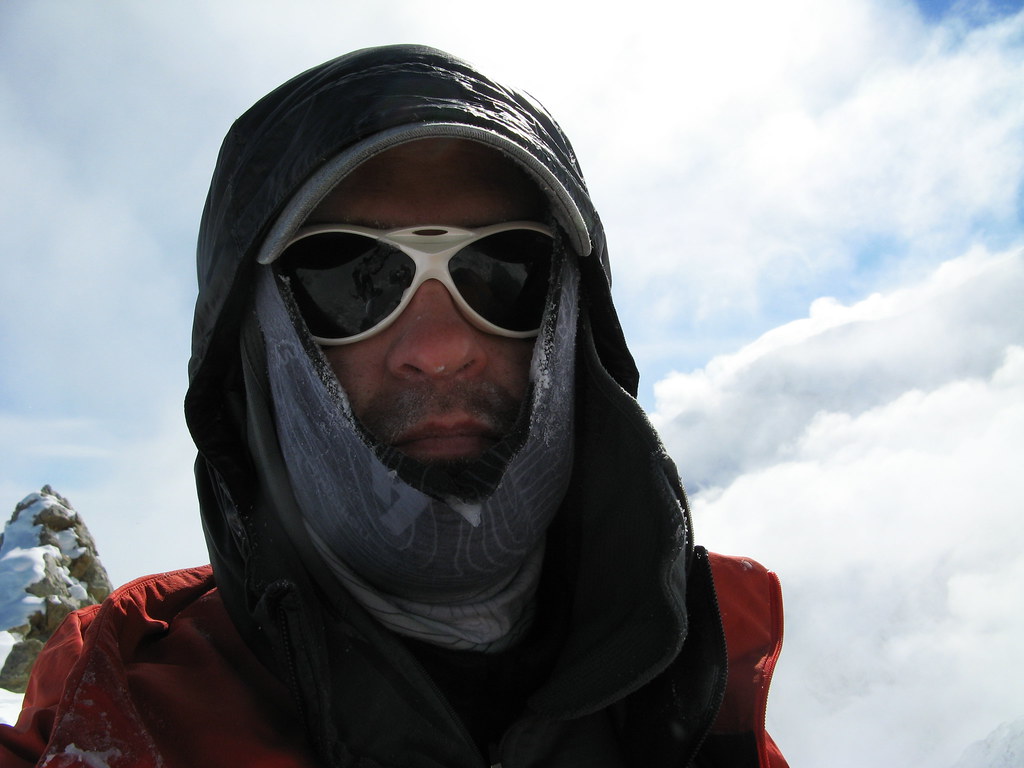 |
| Me... after returning to Camp 2 |
Dinner was a delicious, hot, spicy, sweet, and savory meal that was much needed, and a perfect way to refuel after a hard, cold day of climbing. Then came the hot tea to warm the frozen bones. I soooo needed that.
As it stands, we're planning to move camp up tomorrow, by the same route, and establish a new camp there, or go all the way to the summit, 500 vertical feet above the cache point today, and then maybe do a short back carry to go get the stuff we stashed today.
It all depends on the weather, though. The weather report that crackled over the radio from the NPS sounded non-promising, though. Nate called in to AMS to double check with Rob Gowler and to get his take on tomorrow's weather. It's still uncertain, he said. I guess we'll know when we poke our heads out our tent in the morning.
I'm pretty proud of my performance today, though. Leading on the way down was a new experience, and found me frequently banging in pickets or twisting in ice screws and clipping in. We had all found a really nice rhythm together in both directions, and today, I was exposed to a surge of experiences that have forever changed me.
We'll see what tomorrow holds.
